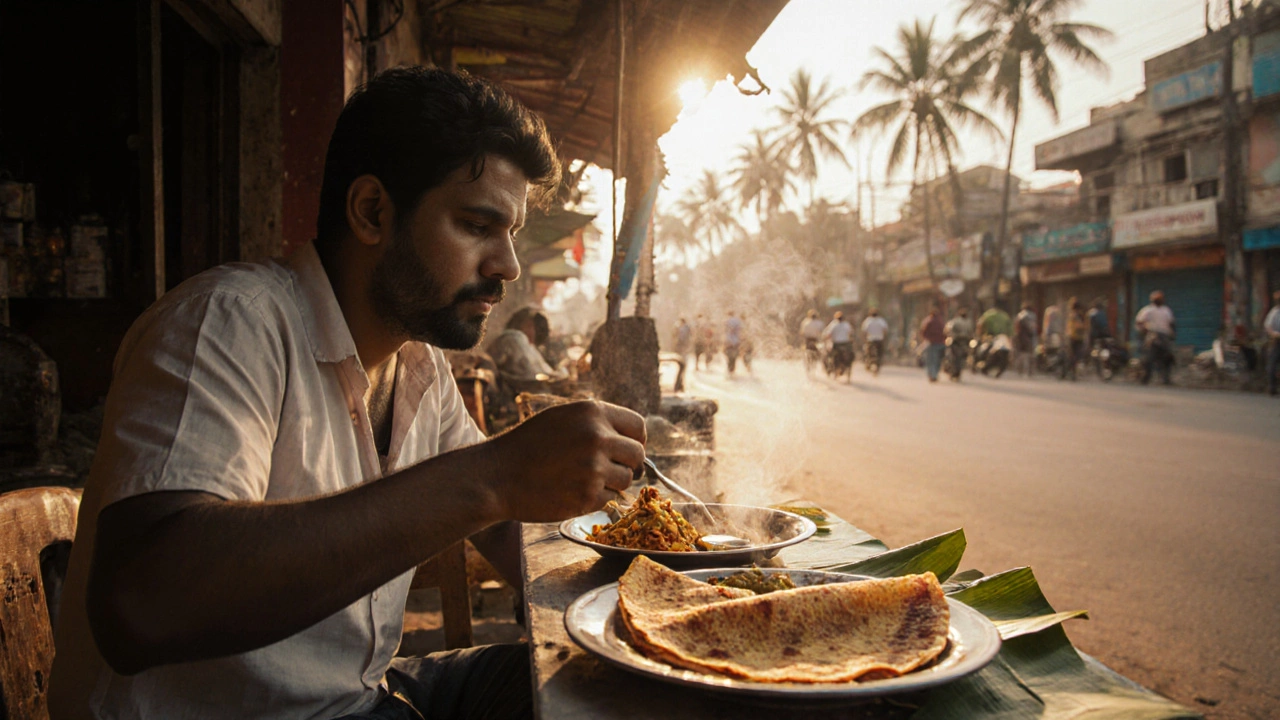SEARCH
How Much Money Do I Need to Travel to India for 2 Weeks? South India Budget Guide


South India Travel Budget Calculator
Customize Your South India Trip Budget
Estimate your total costs for a 2-week trip to South India based on your travel style and preferences.
Your budget estimate will appear here after calculation
Save money tips: Use local trains, eat at street food stalls, and book accommodations directly through MakeMyTrip or Goibibo.
Planning a two-week trip to South India doesn’t have to mean maxing out your credit card. You can explore ancient temples, relax on quiet beaches, and hike through misty hills without spending a fortune-if you know where to cut costs and where to splurge. The truth? Most travelers spend between $800 and $2,000 for two weeks in South India, depending on their style. This guide breaks down exactly where your money goes, so you don’t overpay and you don’t miss out.
Accommodation: Where You’ll Spend the Most (and How to Save)
Where you sleep makes the biggest difference in your budget. In cities like Chennai, Bangalore, and Kochi, you can find clean, private rooms in guesthouses for $15-$25 a night. Hostels with dorm beds drop even lower-$8-$12-if you don’t mind sharing. In smaller towns like Gokarna or Mahabalipuram, homestays run $10-$18 and often include breakfast. If you’re looking for luxury, boutique hotels with pools start around $70-$100, but you don’t need one to enjoy the region.
Pro tip: Book directly through local websites like MakeMyTrip or Goibibo. They often have better rates than international platforms, especially for last-minute stays. Avoid tourist traps near major temples or beaches-those places jack up prices just because they’re convenient.
Food: Eat Like a Local, Not Like a Tourist
Food in South India is cheap, delicious, and everywhere. A plate of dosa, sambar, and coconut chutney at a local eatery costs $1-$2. Street food like vada pav, idli, or fresh banana leaf meals run $0.50-$1.50. You can fill up for under $5 a day if you stick to local joints.
Restaurant meals with air conditioning and English menus? That’s where prices climb. A simple thali at a mid-range place might cost $5-$8. Seafood in coastal towns like Pondicherry or Kovalam can hit $10-$15 if you’re near the beachfront. Skip the tourist restaurants and walk a few blocks inland. Locals know where the best food is-and it’s never on the main drag.
Drinks are cheap too. A bottle of water is $0.30, a local beer is $1.50, and fresh coconut water from a vendor? $0.50. Bottled water is fine, but carry a reusable bottle with a filter-it saves money and plastic.
Transportation: Trains, Tuk-Tuks, and Local Buses
Getting around South India is easy and affordable. Long-distance trains are the best value. A second-class sleeper ticket from Bangalore to Mysore (about 150 km) costs $5-$8. A 12-hour ride from Chennai to Kochi? Around $15. Book through the IRCTC app-it’s reliable and lets you reserve seats weeks ahead.
For shorter trips, buses are even cheaper. State-run KSRTC or TNSTC buses run every hour between major towns and cost $1-$4 for a 2-3 hour ride. Tuk-tuks are fun, but negotiate the price before you get in. A 10-minute ride in Cochin might cost $2; if the driver says $10, walk away. Auto-rickshaws with meters are rare, so always agree on a fare upfront.
Private taxis for day trips (like from Pondicherry to Auroville) cost $25-$40 for 6-8 hours. If you’re traveling with 2-3 people, splitting it makes sense. Otherwise, stick to public transport.
Attractions and Entry Fees: Don’t Get Ripped Off
Most temples in South India charge $1-$3 for foreigners. Some, like the Meenakshi Temple in Madurai, are free. The famous Mysore Palace charges $8 for foreigners-worth every rupee. UNESCO sites like Hampi and Mahabalipuram cost $10-$15 per person. Many hill stations like Ooty and Kodaikanal don’t charge entry at all.
Guided tours? Skip the big tour companies. Instead, hire a local guide at the site. A knowledgeable local at Hampi might charge $10-$15 for a 3-hour walk. They’ll tell you stories no guidebook can. Avoid packages that include meals or transport unless you’re sure they’re legit.
Don’t pay for unnecessary extras. Some temples ask for donations or “special darshan” tickets. These aren’t mandatory. If someone pressures you, just say no. Most temples are open to everyone.

What You Should Budget Per Day
Here’s a realistic daily breakdown based on mid-range travel:
- Accommodation: $20
- Food: $8
- Local transport: $5
- Attractions: $5
- Extras (souvenirs, drinks, tips): $7
Total: $45 per day. For 14 days, that’s $630. Add $200 for flights (if you’re coming from Southeast Asia or the Middle East) and $150 for emergencies or unplanned splurges. That brings you to $980 total.
If you want more comfort-private rooms, nicer restaurants, occasional taxis-budget $70-$80 per day. That’s $1,000-$1,200 for two weeks, plus flights.
On a tight budget? Cut accommodation to $10/day, eat only street food ($3/day), and use buses. You can do South India for under $500, not including flights.
Flights: The Big Variable
Flights to India vary wildly. From the U.S., round-trip tickets to Bangalore or Chennai start at $700-$1,000 in low season (May-September). From Europe, expect $500-$800. From Dubai or Singapore, you can find deals under $300. Book 3-4 months ahead. Use Google Flights and set alerts. Avoid flying into Delhi or Mumbai if you’re going to South India-it adds unnecessary travel time and cost.
Once you land, domestic flights between cities like Bangalore and Kochi cost $40-$70. But unless you’re short on time, take the train. It’s cheaper, scenic, and gives you a real feel for the country.
Hidden Costs You Can’t Ignore
Some expenses sneak up on you:
- Travel insurance: $30-$60 for two weeks (get one that covers medical emergencies)
- Sim card: $5-$10 for 10GB of data (Airtel or Jio work everywhere)
- ATM fees: Your bank might charge $3-$5 per withdrawal. Withdraw larger amounts to reduce fees
- Tipping: Not required, but $1-$2 for good service at restaurants or hotels is appreciated
- Visa: $100 for a 10-year tourist visa (e-Visa only-apply online before you go)
Don’t forget to carry some cash. Many small shops, temples, and street vendors don’t take cards. ATMs are everywhere, but they can run out in rural areas.
When to Go: Save Money by Timing Right
The best time to visit South India is October to March. The weather is dry and pleasant. But that’s also peak season. Prices rise, hotels fill up, and flights get expensive.
If you want the lowest prices and fewer crowds, go in April or May. It’s hot-temperatures hit 35°C (95°F)-but you’ll pay 30-40% less for everything. Just plan for heat: stay hydrated, avoid midday sun, and book places with AC.
Monsoon season (June-September) is quiet and green. Some hill stations like Munnar are stunning in the rain. But coastal areas can flood, and some boat tours cancel. If you’re flexible, this is when locals say you get the real India.

What to Pack to Save Money (and Stress)
You don’t need much:
- Light, breathable clothes (cotton and linen)
- Comfortable walking shoes
- Reusable water bottle with filter
- Small power bank (charging stations are rare outside hotels)
- Basic first-aid kit (diarrhea meds, painkillers, antiseptic)
- Universal adapter (India uses Type C, D, and M plugs)
Buy sunscreen, mosquito repellent, and toiletries there. They’re cheaper and better suited to the climate than what you bring from home.
Final Budget Breakdown: Real Numbers
Here’s what two weeks in South India actually costs, based on real traveler reports:
| Category | Budget Traveler ($) | Mid-Range Traveler ($) | Luxury Traveler ($) |
|---|---|---|---|
| Flights (round-trip) | 700 | 800 | 1,200 |
| Accommodation (14 nights) | 140 | 280 | 700 |
| Food & Drinks | 110 | 180 | 350 |
| Transport (trains, buses, tuk-tuks) | 70 | 120 | 200 |
| Attractions & Entry Fees | 50 | 80 | 150 |
| Visa & Insurance | 130 | 130 | 130 |
| Sim Card & Extras | 20 | 40 | 80 |
| Total | $1,220 | $1,630 | $2,810 |
Most travelers land in the mid-range bracket. You get good food, clean rooms, reliable transport, and all the cultural experiences without breaking the bank.
What You’ll Miss If You Skip South India
It’s not just about the cost. It’s about what you get for that money. You’ll walk through 1,000-year-old stone temples where chants echo under carved pillars. You’ll sip filter coffee in a quiet courtyard while rain taps on the roof. You’ll ride a backwater houseboat at sunset, with nothing but water, palms, and the occasional kingfisher. None of this requires luxury. It just requires being there.
South India doesn’t ask you to spend big. It asks you to slow down, pay attention, and taste the life around you. That’s the real value.
Is $1,000 enough for two weeks in South India?
Yes, if you’re careful. $1,000 covers flights (if you find a deal), basic lodging, local food, trains, and entry fees. You won’t eat at fancy restaurants or stay in 5-star hotels, but you’ll see everything important. Cut costs by using buses, eating street food, and booking hostels. Skip expensive day trips and stick to free temples and beaches.
Can I travel South India without a car?
Absolutely. South India has one of the best public transport networks in the country. Trains connect all major cities. Buses run frequently between towns. Tuk-tuks and auto-rickshaws handle short trips. You don’t need a car unless you’re planning to explore remote hill villages. Even then, you can hire a driver for a day for under $40.
Is South India safe for solo travelers?
Yes, especially in tourist areas like Mysore, Pondicherry, Kochi, and Hampi. Women traveling alone should dress modestly, avoid walking alone at night in unfamiliar areas, and trust their gut. Most locals are helpful and respectful. Use common sense-you’re safer here than in many Western cities.
How much cash should I carry?
Carry $100-$150 in cash for small purchases, temple donations, and rural areas where cards aren’t accepted. Use ATMs to withdraw more as needed. Most hotels and restaurants in cities take cards, but street vendors, local buses, and small shops only take rupees. Keep small bills handy-$1, $5, and $10 notes are most useful.
Do I need vaccinations to travel to South India?
No vaccines are required, but it’s smart to be up to date on routine ones like typhoid, hepatitis A, and tetanus. Malaria isn’t common in most tourist areas, but use mosquito repellent. Drink bottled or filtered water. Most travelers get by fine with basic precautions-no need for extreme measures.
Next Steps: Start Planning
Decide your route: Chennai → Mahabalipuram → Pondicherry → Thanjavur → Madurai → Kochi → Munnar → back to Bangalore. That’s a classic 14-day loop. Book your flights early. Reserve your first 3 nights’ stays before you go. Download offline maps and the IRCTC app. Pack light. And don’t stress about the budget-you’ll find your rhythm once you’re there.